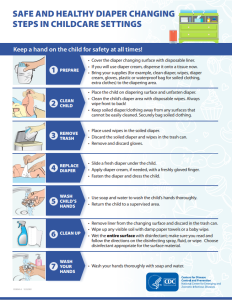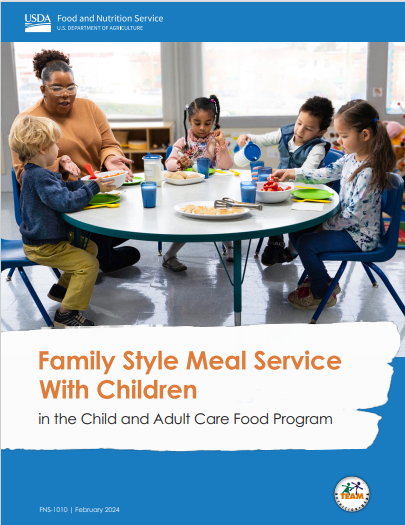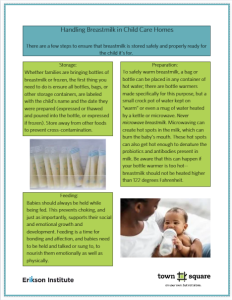If you are curious about family style dining, whether or not you’re currently on the food program, this short booklet will show you all the equipment you need, how to introduce the idea to children and their families, and tips for ensuring compliance with CACFP regulations.
Family Style Meal Service With Children in the Child and Adult Care Food Program (cacfp.org)
One of the joys of family child care is the length of time providers can spend with the children in their care, and the growth that happens in those years. This also means that providers need to remain adaptable, and ready to change their program alongside the children. Communicating with families at enrollment and checking in regularly about when and how long children are sleeping, how often they’re eating, and their state when they get home (overtired? awake until 11?) can help inform routines as children grow.
Of course, in mixed age groups, it’s very likely that there will be children who have seemingly conflicting needs at the same time. How can one provider offer an active preschooler adequate time outdoors, while also feeding infants as they get hungry, and attend to toileting and diapering needs as the pop up?
There are three things to keep in mind to balance it all (most days!):
- Preparation: Communicating with families about young children’s needs, as well as using the provider’s own observations, should inform the construction of the routine. Not only should each child be considered as an individual, but the group as a whole serves as another perspective to consider. Every time the group composition changes, there’s a good chance some part of the routine will as well.
- Equipment: Ideally, there should be spaces indoors and out for both active and quiet play; resting; and eating. Of course, space can be at a premium in any child care setting, so adaptability is key. Can a waterproof box with diapers, wipes, diaper table paper, soap and paper towels live near your garden hose?
- Flexibility: don’t let the clock stress you out– it’s a reference point, not your boss. If the children are contentedly playing, don’t let the clock tell you or them that it’s time to stop! Conversely, if some are clearly tired and hungry, feel free to move lunch and rest time accordingly. While many states have regulations that require infants to be fed and given naps on a highly individualized schedule, it’s okay to let a tired child rest or a hungry child have a cup of milk or other snack outside of scheduled meal times.
For Reflection:
What times of day are the most challenging to meet everyone’s needs?
What would support you in partnering with families around children’s need for routine?
Handling, storing, heating, and feeding breastmilk can feel like it has a lot of steps.
This printable PDF reviews how to safely provide breastmilk to infants whose families provide it, including storage, preparation, and feeding. Below, you’ll also find a video from Head Start showing an Early Head Start teacher bottle feeding an infant and demonstrating responsive feeding and interaction with a baby at feeding time.
Gestión de la leche materna en cuidado de los niños
What do you notice in this video of the Early Head Start teacher feeding the baby? How does the baby respond to her actions and speech?
In the RIE philosophy, there is a great emphasis on ensuring that caregiving times are relaxed and enjoyable for children and their caregivers. While this might be a dramatic reframe for some– is it really possible to enjoy changing diapers? — it can make mundane tasks much more pleasant.
Family child care is a unique profession– some days drag out, but many others fly by. Taking any opportunity to slow down and be mindfully present with the children is a way to build relationships with each child and ensure that there is time each day spent in warm individual interactions.
The major criterion that makes an activity “want something” quality time is that the adult has an agenda for the child to participate in. This is typically participating in a care task like diapering/toileting, feeding/eating, or dressing. How can these sometimes stressful occasions become enjoyable for everyone? The answer is simple: play!
When a child is getting changed, songs and nursery rhymes (“This Little Piggy”, “Hickory, Dickory, Dock”) have natural gestures that can be incorporated into dressing the child. Taking some pressure off of meals and offering conversation or even calm games for older toddlers, like “I spy on my plate” or discussing the attributes of the meal.
It’s normal for a child to offer some resistance during care times; babies and toddlers try to roll away from diaper changes, or spit out food, or tantrum to avoid getting dressed. Approaching the child in the spirit of collaboration and fun, while not an immediate “cure” for these behaviors, will change the tone of these interactions over time.
Reflection Questions:
- What “want something” times are most difficult right now?
- Consider a child you have struggled to connect with, or who struggles when participating in care tasks: how and when could you use want something quality time to build that relationship?
In the Paths to Quality Standards for Participation, there are 13 standards that family child care providers must meet to move from level 1 to level 2. One practice states:
Each child feels safe, accepted, and protected. This is supported by daily practices that reinforce respect for people, feelings, ideas, and materials.
What does it mean to feel safe, accepted, and protected? What are daily practices that support children in feeling this way? Paying attention to each child and taking advantage of time to connect, even though this is difficult in group care, is a great start. Especially during caregiving times like feeding and diapering/toileting when children are at their most vulnerable. In the RIE philosophy of infant caregiving, this is called “want something quality time.” When the adult has a goal, but it can be accomplished mutually with the child’s cooperation, and the time can be spent in a pleasant interaction with the child rather than rushed through.
This is in addition to “want nothing quality time,” when adults spend time playing with, talking to, and observing children without another agenda. Helping children feel safe also involves self-reflection. Knowing how to handle children’s challenging behaviors is an ongoing process and requires some self-reflection to ensure that adult responses are compassionate and appropriate and demonstrate to the child that the adult isn’t a threat. It’s easy to forget that adults are many times the size of a young child and can easily feel frightening to them. As Circle of Security says, the adult must choose to be “bigger, stronger, wiser, and kind.”
Respect for ideas is simply listening to children and helping them have discussions together in a way that allows for free expression of thoughts without ridicule.
Respect for materials might be more complicated. One of the greatest frustrations in family child care can be broken materials! But daily practices that can support respect for materials might include helping children choose the right materials for their chosen activity (throwing sponge balls instead of blocks), and teaching and modeling appropriate use of materials such as paintbrushes and markers.
Reflection:
- How can you tell when a child is feeling safe?
- What frequent occurrence is most likely to dysregulate you? Spilled paint? Children squealing? How can you proactively support your own wellness and calm?
This printable PDF from the CDC
outlines the steps involved for a diaper change that minimizes the chance of spreading pathogens such as pinworms or hand foot and mouth. These are crucial to the health and safety of the provider and all of the children they care for.
What it doesn’t show is the incredible opportunity for relationship building that is also present at every diaper change. How often are you just a foot or so away from the child’s face for such a focused time? Spending diaper changes talking to the child is one high-impact way to build relationships, and also make the diaper changes themselves easier. What toddler is going to try to roll or wrestle away when one of their favorite people is talking to them, or playing “this little piggy” with their toes?
It doesn’t add a significant amount of time to really pay attention to the child being changed, but the payoff in peaceful diapering and overall relationship can’t be overstated!


